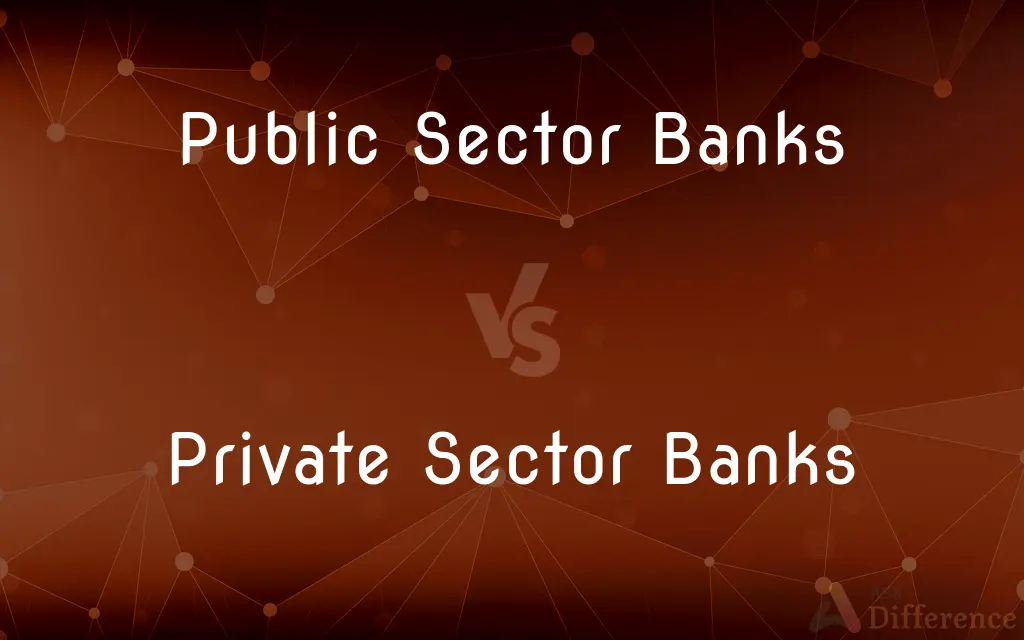Public Sector Banks vs. Private Sector Banks — What's the Difference?
By Tayyaba Rehman — Published on October 17, 2023
Public Sector Banks are owned by the government, focusing on social objectives, while Private Sector Banks are owned by private entities, emphasizing profitability.

Difference Between Public Sector Banks and Private Sector Banks
Table of Contents
ADVERTISEMENT
Key Differences
Public Sector Banks and Private Sector Banks are two distinct types of banking institutions, each with its own set of objectives and operational nuances. Public Sector Banks are primarily owned by the government, often focusing on wider social objectives like financial inclusion, economic development, and social equity. These banks tend to have an extensive reach, especially in rural and remote areas, catering to the diverse needs of the population. On the other hand, Private Sector Banks are owned by private entities or individuals, with a primary focus on profitability and shareholder value.
While Public Sector Banks often operate with a mandate to serve the public interest, Private Sector Banks are driven by market dynamics and customer demand. They are known for their competitive offerings, customer-centric approach, and innovative solutions, often leveraging the latest technology to enhance customer experience and operational efficiency. Conversely, Public Sector Banks, while fulfilling critical societal needs, may lag in terms of innovation and customer service due to bureaucratic processes and regulatory constraints.
Public Sector Banks, owing to their government backing, are often perceived as more secure, which can lead to higher public trust. This security is often mirrored in more conservative banking practices and risk-averse lending policies. In contrast, Private Sector Banks, while adhering to regulatory norms, might adopt more aggressive strategies and flexible policies to expand their customer base and market share, often leading to a wider range of products and services.
One of the main distinctions between Public Sector Banks and Private Sector Banks lies in their operational flexibility and efficiency. Private Sector Banks, free from extensive bureaucratic processes and government intervention, often display higher operational efficiency and adaptability to market changes. Public Sector Banks, with their social objectives, might face challenges in maintaining operational efficiency due to government policies and mandates aimed at social welfare.
Comparison Chart
Ownership
Owned by the government.
Owned by private entities or individuals.
ADVERTISEMENT
Objectives
Focus on social objectives and financial inclusion.
Primarily focused on profitability.
Operational Efficiency
May have bureaucratic processes, less efficient.
Generally more efficient and adaptable.
Risk Approach
More conservative and risk-averse.
May adopt more aggressive strategies.
Service & Innovation
May lag in customer service and innovation.
Known for customer-centricity and innovation.
Compare with Definitions
Public Sector Banks
Public Sector Banks are government-owned institutions.
Many people trust Public Sector Banks due to government ownership.
Private Sector Banks
Private Sector Banks primarily aim at profitability and shareholder value.
The offerings of Private Sector Banks are often driven by market demand and profitability.
Public Sector Banks
Public Sector Banks may have more conservative banking practices.
Public Sector Banks tend to have conservative lending policies to minimize risks.
Private Sector Banks
Private Sector Banks usually have higher operational efficiency.
The adaptability and efficiency of Private Sector Banks are often superior due to less bureaucratic interference.
Public Sector Banks
Public Sector Banks often focus on social objectives and financial inclusion.
Public Sector Banks play a crucial role in rural areas by providing financial services.
Private Sector Banks
Private Sector Banks are known for their innovative solutions and customer-centric approach.
Customers often prefer Private Sector Banks for their innovative banking solutions and superior customer service.
Public Sector Banks
Public Sector Banks usually operate with extensive reach and accessibility.
The extensive network of Public Sector Banks ensures accessibility even in remote areas.
Private Sector Banks
Private Sector Banks may adopt aggressive strategies to expand market share.
To increase their customer base, Private Sector Banks often introduce attractive products and flexible policies.
Public Sector Banks
Public Sector Banks may face operational challenges due to bureaucratic processes.
The operational efficiency of Public Sector Banks may be hindered by extensive government regulations.
Private Sector Banks
Private Sector Banks are owned by private entities or individuals.
Private Sector Banks often offer competitive and diverse services to attract customers.
Share Your Discovery

Previous Comparison
Contempt vs. Disdain
Next Comparison
Fidelity vs. IntegrityAuthor Spotlight
Written by
Tayyaba RehmanTayyaba Rehman is a distinguished writer, currently serving as a primary contributor to askdifference.com. As a researcher in semantics and etymology, Tayyaba's passion for the complexity of languages and their distinctions has found a perfect home on the platform. Tayyaba delves into the intricacies of language, distinguishing between commonly confused words and phrases, thereby providing clarity for readers worldwide.












































